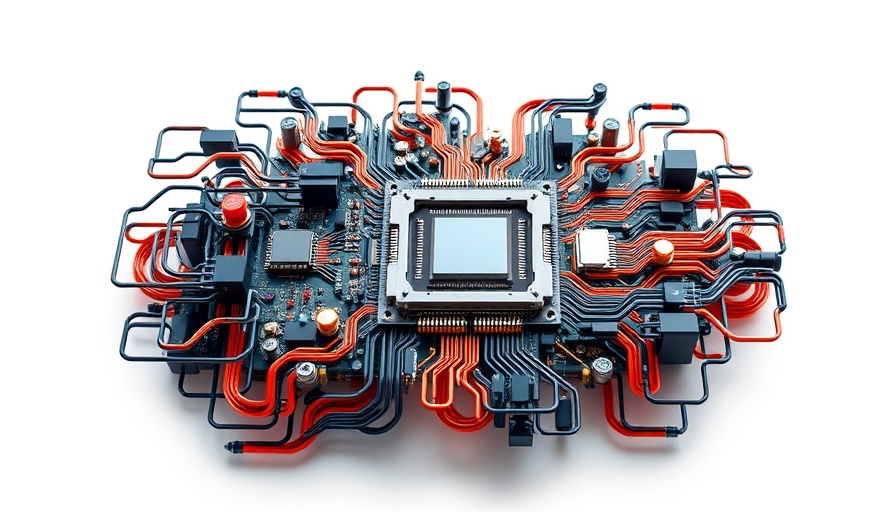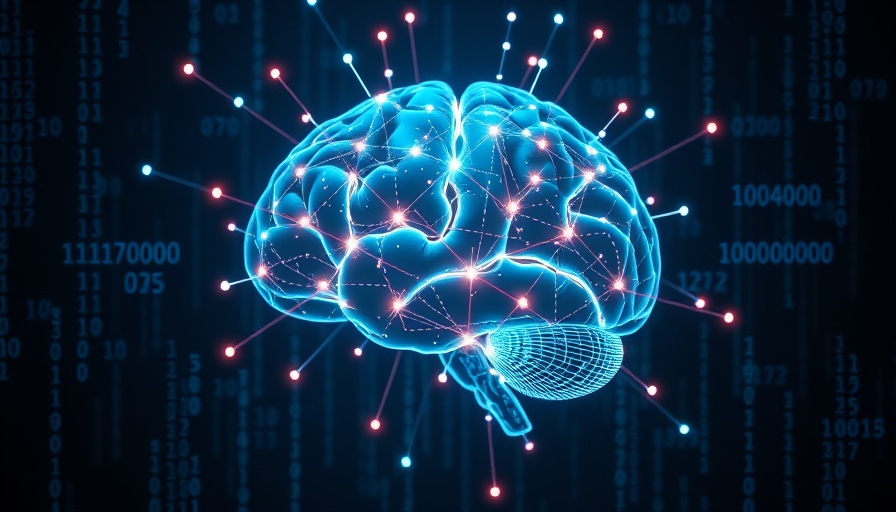
 Add Row
Add Row  Add Element
Add Element Revolutionary Magnetoreceptive E-Skin: The Future of Tech Interactions

2 Views
0 Comments

Quantum Computers Achieve Unconditional Exponential Speedup: A Game Changer for AI
Update The Historic Breakthrough in Quantum Computing Imagine a computer capable of solving problems at lightning speed, its capabilities far surpassing those of traditional computers. This dream is no longer a distant prospect; it has become a reality demonstrated by a recent study from the University of Southern California. Using IBM's advanced 127-qubit processors, researchers have achieved the coveted exponential speedup in quantum computing, a breakthrough that emphasizes the transformative potential of this technology. Clarifying Quantum Speedups: Exponential vs. Polynomial In the realm of quantum computing, speedups are categorized as either polynomial or exponential. Polynomial speedups indicate a manageable increase in performance with the scaling of problems. However, quantum researchers often aim for the Holy Grail: exponential speedup. Professor Daniel Lidar, leading this study, explains that this breakthrough means that as the size of problems grows, the performance gap between quantum and classical machines not only widens but does so incredibly fast—approximately doubling with each added variable. Unconditional Speedup: What Does It Mean? A significant aspect of this achievement is its classification as "unconditional." Unlike previous speedup claims that relied on assumptions—like the absence of a better classical algorithm—this milestone does not depend on conjectures. Lidar's team utilized a modified algorithm to address Simon’s problem, showcasing quantum computers' ability to outperform classical counterparts consistently and predictably. Simon’s Problem: The Key to Unlocking Quantum Power Simon’s problem acts as the cornerstone of quantum computing, revealing hidden patterns within mathematical functions. It has historical significance as it sparked interest in quantum algorithms that could potentially crack codes, paving the way for applications in cybersecurity and medicine. Moreover, unraveling Simon’s problem with exponential speedup symbolizes a pivotal moment in the ongoing evolution of quantum technology. The Future of Quantum Computing: What Lies Ahead? As researchers hone quantum error correction methods and move beyond classical limitations, the implications for industries are profound. From optimizing complex systems in logistics to accelerating drug discovery and enhancing artificial intelligence (AI) capabilities, the vast potential of quantum computing could revolutionize many sectors. Experts anticipate a stronger collaboration between AI and quantum technologies, enabling breakthroughs that were previously unimaginable. Practical Implications for Industries and Society The economic impact of quantum computing could be monumental. With industry giants competing to develop feasible quantum solutions, investment in quantum technologies may surge. This will not only enhance the tech landscape but also create new jobs and revolutionize existing industries. The clear message from this breakthrough is that investments in quantum technology are not just foresight; they are a necessity for businesses aiming to remain competitive in an increasingly complex digital landscape. A Call to Action: Embrace the Quantum Revolution As quantum computing approaches a tipping point, the call to action for industries is clear: invest in understanding and integrating these technologies. This advancement offers multiple pathways for innovation and efficiency, opening doors for businesses and informing thoughtful discussions about the future of AI and technology at large. To stay ahead, stakeholders must engage with the evolving quantum landscape and capitalize on its benefits today.

Discover How Unreal Engine 5.6 is Revolutionizing Virtual Content Creation
Update Revolutionizing Content Creation with Unreal Engine 5.6 Unreal Engine 5.6 emerges as an unprecedented development tool, akin to Tony Stark opening the doors to his workshop. For business owners keen on utilizing the latest technology, this platform represents an incredible opportunity to blend creativity and efficiency, especially in content creation. The new MetaHumans system, which produces high-fidelity virtual humans with remarkable speed, is one of the standout features of this latest release.In 'Unreal Engine 5.6: Outrageously Good!', the discussion dives into the transformative advancements of the platform, exploring key insights that sparked deeper analysis on our end. MetaHumans: The Future of Personalization in Virtual Worlds The power of the MetaHumans technology lies in its accessibility. Users can now create impressive digital avatars using just a standard phone camera. This feature transforms the creative landscape, allowing users not just to envision characters but to integrate themselves directly into virtual environments. Imagine the marketing potential: businesses can leverage digital avatars to create personalized advertising experiences or one-to-one customer interactions in virtual spaces. A Leap Forward in Real-Time Graphics Another impressive enhancement is the improved Lumen system, allowing for more realistic lighting and environmental interactions. For businesses, realistic visuals can enhance product presentations, making virtual demonstrations dramatically more impactful. With real-time ray tracing now more efficient than ever, companies can captivate audiences with striking, lifelike representations of their offerings. Efficient Scalability for Large Projects Business owners working on large-scale projects will appreciate the advancements in loading geometry for extensive virtual landscapes. This improvement not only streamlines the development process but also minimizes bottlenecks that can slow down production timelines. As more businesses pivot toward immersive experiences, this capability allows for quicker iterations and enhanced project scalability. Express Yourself: The Power of Emotion in Characters Unreal Engine 5.6 has introduced more intuitive motion editing tools as well as the ability to sculpt facial expressions on 3D characters in real-time. This accessibility paves the way for businesses in entertainment and training sectors to create relatable characters that resonate with audiences. Enhanced emotional expression opens doors to deeper customer engagement through personalized storytelling. The Key to Realism: Physics and Control Adding real-time physics and ragdoll effects to characters ensures a more organic interaction in virtual worlds. For sectors such as gaming, film, and training simulations, this degree of realism while interacting with characters can dramatically enrich user experience, thereby enhancing the overall effectiveness of the simulation. Materials That Matter: Substrate Materials for Complex Models Furthermore, the Substrate materials feature empowers creators to mix and match various complex material models seamlessly. For businesses focused on product design, the ability to visualize different material combinations accurately can significantly impact product development cycles, leading to better decision-making. Why Now is the Time to Embrace Unreal Engine 5.6 The advancements in Unreal Engine 5.6 present a significant opportunity for business owners across various sectors to engage with their audiences in innovative ways. By integrating high-fidelity virtual content into advertising, training, and product presentations, businesses can gain a competitive edge. The ease of use and the richness of possibilities offered by this platform aligns perfectly with the current trends toward virtual engagement and personalized customer interactions. As you consider the implications of these advancements, it’s clear that leveraging Unreal Engine 5.6 could transform your business strategies. If you want to stay ahead in your industry and create immersive experiences that capture and retain customer attention, it's time to explore how this cutting-edge technology can work for you. GET AI WORKING FOR YOU TODAY. Whether it’s through virtual reality experiences, dynamic content creation, or enhanced advertising, aligning your strategy with these innovations can set you apart from the competition.

Why Understanding Affordances is the Key for AI Evolution
Update A New Understanding of Human Intuition Have you ever considered how you instinctively know whether you can walk down a path or swim in a lake? According to groundbreaking research by scientists at the University of Amsterdam, the secret lies in the brain's ability to recognize affordances—the potential actions that an environment allows. This remarkable capability enables us to navigate various settings effortlessly, tapping into brain functions that remain elusive for artificial intelligence (AI) systems like ChatGPT. The Brain’s Unique Processing Power The research, spearheaded by PhD student Clemens Bartnik and computational neuroscientist Iris Groen, utilized MRI technology to observe brain responses when participants viewed images of different environments. Participants were asked to indicate the possible actions—such as walking, cycling, or swimming—that the images suggested, while their brain activity was recorded. The findings revealed that certain regions of the visual cortex became active based on the perceived affordances—essentially what one could do in that space—rather than just what was visually present. Why AI Falls Short Despite the advancements in AI, these models struggle to grasp the contextual nuances that inform human behavior. While AI can analyze data patterns and simulate conversation, it often lacks the ability to make intuitive judgments about physical environments like humans do. Groen noted that AI has significant lessons to learn from our brain's efficient processing abilities, particularly regarding context-aware decision-making. The Implications for AI Development Understanding the brain's ability to interpret affordances opens exciting avenues for improving AI systems. If AI could integrate this knowledge, it could become more adaptable and user-friendly, enhancing functionalities in robotics, virtual reality, and autonomous vehicles. By incorporating innate human perception into their frameworks, future AI models might better navigate the complexities of the real world, resulting in more sophisticated and nuanced interactions with users. Real-World Examples of Affordances Consider a simple staircase. A human instantly perceives the invitation to climb, but an AI might struggle to interpret that context without explicit instructions. This gap highlights a critical area for AI advancement. From self-driving cars needing to recognize when to slow down for a pedestrian to virtual assistants interpreting user intent accurately, leveraging human-like cognitive processes could activate a new era of intelligent systems. The Future of Human-AI Collaboration The potential for AI to learn from human cognitive capabilities reshapes our understanding of technology's role in society. As we stand at the intersection of neuroscience and artificial intelligence, the future of collaboration looks promising, enabling machines not just to perform tasks but to resonate with human experiences and instincts. This evolution could redefine not just how we interact with machines but also the efficacy and purpose of AI in daily life, making them partners in our shared environments. For those interested in the continuous evolution of AI and its implications on both technology and society, staying informed about these developments is crucial. By engaging with this knowledge, we can harness the power of AI wisely, ensuring it enhances human capabilities rather than diminishes them. Let's explore the depths of AI innovation together and seek insights that foster a more informed, interconnected world.
 Add Row
Add Row  Add Element
Add Element The latest news and updates on AI technology. This blog is meant to be used to get more information and insight into AI.
 Add Element
Add Element  Add Element
Add Element  Add Element
Add Element ABOUT US
We keep people up to date on the AI industry in regards to AI software, marketing, applications and practical uses.
 Add Element
Add Element © 2025 Divine Web Consultants All Rights Reserved. 8595 Pelham Rd Suite 400 #721, Greenville, SC 29341 . Contact Us . Terms of Service . Privacy Policy




Write A Comment